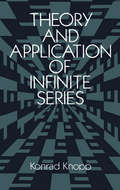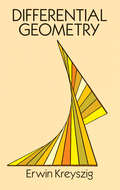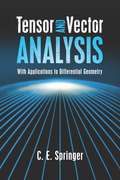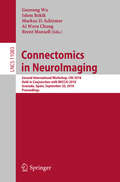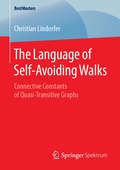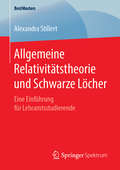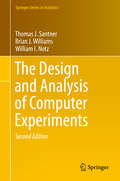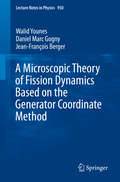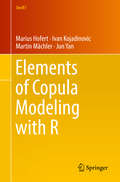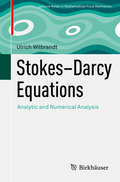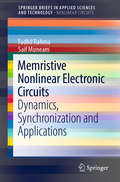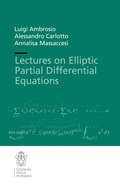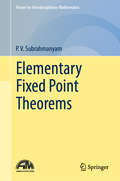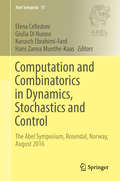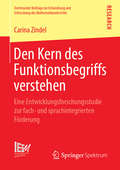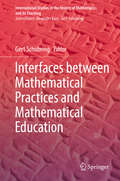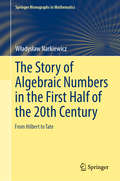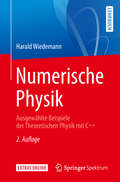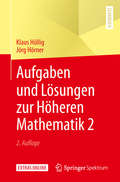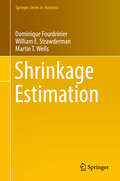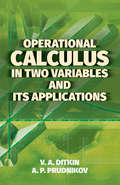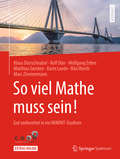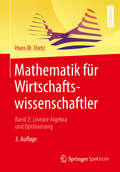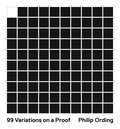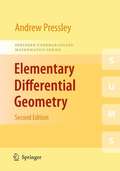- Table View
- List View
Theory and Application of Infinite Series (Dover Books on Mathematics)
by Konrad KnoppThis classic work, written in a clear and interesting style, with many exercises, offers a thorough and reliable treatment of an important branch of higher analysis. It lends itself well to use in course work; however, because of its consistent clear illustrations of theoretical difficulties, the book is also ideal for self-study.Since all higher analysis depends on the theory of numbers, Professor Knopp (formerly Professor of Mathematics, University of Tübingen) begins with an introduction to the theory of real numbers, an indispensable foundation for what is to come. This introduction is followed by an extensive account of the theory of sequences and the actual theory of infinite series. The latter is covered in two stages: (1) the classical theory (2) later developments of the 19th century.Carefully selected exercises have been included throughout, emphasizing applications of the theory, rather than purely theoretical considerations.Aimed at students already acquainted with the elements of differential and integral calculus, this work grew out of the author's lectures and course work at the universities of Berlin and Königsberg. This pedagogical background helped him achieve a work of utmost clarity and precision — one that belongs in the library of every serious mathematician or student of higher analysis.
Differential Geometry (Dover Books on Mathematics)
by Erwin KreyszigThis outstanding textbook by a distinguished mathematical scholar introduces the differential geometry of curves and surfaces in three-dimensional Euclidean space. The subject is presented in its simplest, most essential form, but with many explanatory details, figures and examples, and in a manner that conveys the geometric significance and theoretical and practical importance of the different concepts, methods and results involved.The first chapters of the book focus on the basic concepts and facts of analytic geometry, the theory of space curves, and the foundations of the theory of surfaces, including problems closely related to the first and second fundamental forms. The treatment of the theory of surfaces makes full use of the tensor calculus.The later chapters address geodesics, mappings of surfaces, special surfaces, and the absolute differential calculus and the displacement of Levi-Cività. Problems at the end of each section (with solutions at the end of the book) will help students meaningfully review the material presented, and familiarize themselves with the manner of reasoning in differential geometry.
Tensor and Vector Analysis: With Applications to Differential Geometry (Dover Books on Mathematics)
by C. E. SpringerConcise and user-friendly, this college-level text assumes only a knowledge of basic calculus in its elementary and gradual development of tensor theory. The introductory approach bridges the gap between mere manipulation and a genuine understanding of an important aspect of both pure and applied mathematics.Beginning with a consideration of coordinate transformations and mappings, the treatment examines loci in three-space, transformation of coordinates in space and differentiation, tensor algebra and analysis, and vector analysis and algebra. Additional topics include differentiation of vectors and tensors, scalar and vector fields, and integration of vectors. The concluding chapter employs tensor theory to develop the differential equations of geodesics on a surface in several different ways to illustrate further differential geometry.
Connectomics in NeuroImaging: First International Workshop, Cni 2017, Held In Conjunction With Miccai 2017, Quebec City, Qc, Canada, September 14, 2017, Proceedings (Lecture Notes in Computer Science #10511)
by Brent Munsell Ai Wern Chung Markus D. Schirmer Islem Rekik Guorong WuThis book constitutes the refereed proceedings of the Second International Workshop on Connectomics in NeuroImaging, CNI 2018, held in conjunction with MICCAI 2018 in Granada, Spain, in September 2018. The 15 full papers presented were carefully reviewed and selected from 20 submissions. The papers deal with new advancements in network construction, analysis, and visualization techniques in connectomics and their use in clinical diagnosis and group comparison studies as well as in various neuroimaging applications.
The Language of Self-Avoiding Walks: Connective Constants of Quasi-Transitive Graphs (BestMasters)
by Christian LindorferThe connective constant of a quasi-transitive infinite graph is a measure for the asymptotic growth rate of the number of self-avoiding walks of length n from a given starting vertex. On edge-labelled graphs the formal language of self-avoiding walks is generated by a formal grammar, which can be used to calculate the connective constant of the graph. Christian Lindorfer discusses the methods in some examples, including the infinite ladder-graph and the sandwich of two regular infinite trees.
Allgemeine Relativitätstheorie und Schwarze Löcher: Eine Einführung für Lehramtsstudierende (BestMasters)
by Alexandra StillertAlexandra Stillert bietet eine kompakte Einführung in die Gedankengänge der Allgemeinen Relativitätstheorie. Dabei legt sie die wichtigsten Erkenntnisse aus rund 100 Jahren Relativitätstheorie dar und widmet sich mit ihrer Hilfe den Phänomenen eines der faszinierendsten Forschungsgebiete, den Schwarzen Löchern. Die Autorin erforscht deren Entstehung und Besonderheiten sowie in ein Schwarzes Loch fallende Astronauten. Diese Arbeit umfasst explizite mathematische Rechnungen und Gedankenexperimente, die einen geeigneten Zugang für Lehramtsstudierende der Physik ermöglichen.
The Design and Analysis of Computer Experiments (Springer Series in Statistics)
by Thomas J. Santner Brian J. Williams William I. NotzThis book describes methods for designing and analyzing experiments that are conducted using a computer code, a computer experiment, and, when possible, a physical experiment. Computer experiments continue to increase in popularity as surrogates for and adjuncts to physical experiments. Since the publication of the first edition, there have been many methodological advances and software developments to implement these new methodologies. The computer experiments literature has emphasized the construction of algorithms for various data analysis tasks (design construction, prediction, sensitivity analysis, calibration among others), and the development of web-based repositories of designs for immediate application. While it is written at a level that is accessible to readers with Masters-level training in Statistics, the book is written in sufficient detail to be useful for practitioners and researchers. New to this revised and expanded edition:• An expanded presentation of basic material on computer experiments and Gaussian processes with additional simulations and examples • A new comparison of plug-in prediction methodologies for real-valued simulator output• An enlarged discussion of space-filling designs including Latin Hypercube designs (LHDs), near-orthogonal designs, and nonrectangular regions• A chapter length description of process-based designs for optimization, to improve good overall fit, quantile estimation, and Pareto optimization • A new chapter describing graphical and numerical sensitivity analysis tools• Substantial new material on calibration-based prediction and inference for calibration parameters • Lists of software that can be used to fit models discussed in the book to aid practitioners
A Microscopic Theory of Fission Dynamics Based on the Generator Coordinate Method (Lecture Notes in Physics #950)
by Walid Younes Daniel Marc Gogny Jean-François BergerThis book introduces a quantum-mechanical description of the nuclear fission process from an initial compound state to scission. Issues like the relevant degrees of freedom throughout the process, the way of coupling collective and intrinsic degrees during the fission process, and how a nucleus divides into two separate daughters in a quantum-mechanical description where its wave function can be non-local, are currently being investigated through a variety of theoretical, computational, and experimental techniques. The term “microscopic” in this context refers to an approach that starts from protons, neutrons, and an effective (i.e., in-medium) interaction between them. The form of this interaction is inspired by more fundamental theories of nuclear matter, but still contains parameters that have to be adjusted to data. Thus, this microscopic approach is far from complete, but sufficient progress has been made to warrant taking stock of what has been accomplished so far. The aim is to provide, in a pedagogical and comprehensive manner, one specific approach to the fission problem, originally developed at the CEA Bruyères-le-Châtel Laboratory in France.Intended as a reference for advanced graduate students and researchers in fission theory as well as for practitioners in the field, it includes illustrative examples throughout the text to make it easier for the reader to understand, implement, and verify the formalism presented.
Elements of Copula Modeling with R (Use R!)
by Marius Hofert Ivan Kojadinovic Martin Mächler Jun YanThis book introduces the main theoretical findings related to copulas and shows how statistical modeling of multivariate continuous distributions using copulas can be carried out in the R statistical environment with the package copula (among others). Copulas are multivariate distribution functions with standard uniform univariate margins. They are increasingly applied to modeling dependence among random variables in fields such as risk management, actuarial science, insurance, finance, engineering, hydrology, climatology, and meteorology, to name a few.In the spirit of the Use R! series, each chapter combines key theoretical definitions or results with illustrations in R. Aimed at statisticians, actuaries, risk managers, engineers and environmental scientists wanting to learn about the theory and practice of copula modeling using R without an overwhelming amount of mathematics, the book can also be used for teaching a course on copula modeling.
Stokes–Darcy Equations: Analytic and Numerical Analysis (Advances in Mathematical Fluid Mechanics)
by Ulrich WilbrandtThis book offers a thorough guide starting from fundamental functional analysis leading to the coupling of Stokes and Darcy equations, including numerical analysis and scientific computing. Almost all intermediate results are given with complete, rigorous proofs, including theorems which can be rarely found in the literature such that this book serves well as a reference on the topic. Special care is taken to analyze the difficult cases of non-smooth interfaces which are not completely enclosed in one subdomain, i.e, intersect with the outer boundary. This can hardly be found in the literature. Additionally, known and new subdomain iterative methods are introduced, analyzed and applied to standard examples as well as one example motivated by a geoscientific setting.
Memristive Nonlinear Electronic Circuits: Dynamics, Synchronization and Applications (SpringerBriefs in Applied Sciences and Technology)
by Fadhil Rahma Saif MuneamMemristive Nonlinear Electronic Circuits deals with nonlinear systems in the design and implementation of circuits for generating complex dynamics. The brief proposes a new memristor model using an inverse tangent function, which achieves the characteristics of the memristor and can be implemented easily because it corresponds to the bipolar transistor differential pair. The authors design a new model-based memristive time-delay system by obtaining a time-delay memristive differential equation, which can generate an n-scroll chaotic attractor by adjusting the proposed nonlinear function. These designs are carried out using OrCAD-PSpice. The brief also presents a new time-delay memristive circuit excited by a nonautonomous staircase function which can generate grid chaotic attractors: new families of grids of n×m-scrolls. For increasingly complex dynamics of the circuits, the authors propose a new five-dimensional autonomous system with two memristors. The dynamical characteristics are investigated by phase portraits and bifurcation diagrams. The brief applies two synchronization methods to the memristive circuits: PC synchronization, and feedback control synchronization. The authors consider synchronization as the idea underlying idea the applications in nonlinear electronic circuits. Finally, the double-memristor system is employed to give rise to a highly secure dual-stage encryption technique.
Lectures on Elliptic Partial Differential Equations (Publications of the Scuola Normale Superiore #18)
by Luigi Ambrosio Alessandro Carlotto Annalisa MassaccesiThe book originates from the Elliptic PDE course given by the first author at the Scuola Normale Superiore in recent years. It covers the most classical aspects of the theory of Elliptic Partial Differential Equations and Calculus of Variations, including also more recent developments on partial regularity for systems and the theory of viscosity solutions.
Elementary Fixed Point Theorems (Forum for Interdisciplinary Mathematics)
by P. V. SubrahmanyamThis book provides a primary resource in basic fixed-point theorems due to Banach, Brouwer, Schauder and Tarski and their applications. Key topics covered include Sharkovsky’s theorem on periodic points, Thron’s results on the convergence of certain real iterates, Shield’s common fixed theorem for a commuting family of analytic functions and Bergweiler’s existence theorem on fixed points of the composition of certain meromorphic functions with transcendental entire functions. Generalizations of Tarski’s theorem by Merrifield and Stein and Abian’s proof of the equivalence of Bourbaki–Zermelo fixed-point theorem and the Axiom of Choice are described in the setting of posets. A detailed treatment of Ward’s theory of partially ordered topological spaces culminates in Sherrer fixed-point theorem. It elaborates Manka’s proof of the fixed-point property of arcwise connected hereditarily unicoherent continua, based on the connection he observed between set theory and fixed-point theory via a certain partial order. Contraction principle is provided with two proofs: one due to Palais and the other due to Barranga. Applications of the contraction principle include the proofs of algebraic Weierstrass preparation theorem, a Cauchy–Kowalevsky theorem for partial differential equations and the central limit theorem. It also provides a proof of the converse of the contraction principle due to Jachymski, a proof of fixed point theorem for continuous generalized contractions, a proof of Browder–Gohde–Kirk fixed point theorem, a proof of Stalling's generalization of Brouwer's theorem, examine Caristi's fixed point theorem, and highlights Kakutani's theorems on common fixed points and their applications.
Computation and Combinatorics in Dynamics, Stochastics and Control: The Abel Symposium, Rosendal, Norway, August 2016 (Abel Symposia #13)
by Elena Celledoni Giulia Di Nunno Kurusch Ebrahimi-Fard Hans Zanna Munthe-KaasThe Abel Symposia volume at hand contains a collection of high-quality articles written by the world’s leading experts, and addressing all mathematicians interested in advances in deterministic and stochastic dynamical systems, numerical analysis, and control theory. In recent years we have witnessed a remarkable convergence between individual mathematical disciplines that approach deterministic and stochastic dynamical systems from mathematical analysis, computational mathematics and control theoretical perspectives. Breakthrough developments in these fields now provide a common mathematical framework for attacking many different problems related to differential geometry, analysis and algorithms for stochastic and deterministic dynamics. In the Abel Symposium 2016, which took place from August 16-19 in Rosendal near Bergen, leading researchers in the fields of deterministic and stochastic differential equations, control theory, numerical analysis, algebra and random processes presented and discussed the current state of the art in these diverse fields. The current Abel Symposia volume may serve as a point of departure for exploring these related but diverse fields of research, as well as an indicator of important current and future developments in modern mathematics.
Den Kern des Funktionsbegriffs verstehen: Eine Entwicklungsforschungsstudie zur fach- und sprachintegrierten Förderung (Dortmunder Beiträge zur Entwicklung und Erforschung des Mathematikunterrichts #40)
by Carina ZindelSprache ist zugleich Lernmedium und Lerngegenstand, insbesondere beim Aufbau eines konzeptuellen Verständnisses zu mathematischen Konzepten. Carina Zindel identifiziert vor diesem Hintergrund konzeptuelle und sprachliche Anforderungen, die Lernende beim Umgang mit funktionalen Zusammenhängen bewältigen müssen. Ihre tiefgehenden Analysen von Lernprozessen bei einem von ihr entwickelten fach- und sprachintegrierten Lehr-Lern-Arrangement geben Einblicke, wie beim Aufbau von Funktionsverständnis die konzeptuell-kognitiven und sprachlichen Prozesse miteinander verwoben sind.
Interfaces between Mathematical Practices and Mathematical Education (International Studies in the History of Mathematics and its Teaching)
by Gert SchubringThis contributed volume investigates the active role of the different contexts of mathematics teaching on the evolution of the practices of mathematical concepts, with particular focus on their foundations. The book aims to deconstruct the strong and generally wide-held conviction that research in mathematics constitutes the only driving force for any progress in the development of mathematics as a field. In compelling and convincing contrast, these chapters aim to show the productive function of teaching, showcasing investigations from countries and regions throughout various eras, from Old Babylonia through the 20th Century. In so doing, they provide a critical reflection on the foundations of mathematics, as well as instigate new research questions, and explore the interfaces between teaching and research.
The Story of Algebraic Numbers in the First Half of the 20th Century: From Hilbert to Tate (Springer Monographs in Mathematics)
by Władysław NarkiewiczThe book is aimed at people working in number theory or at least interested in this part of mathematics. It presents the development of the theory of algebraic numbers up to the year 1950 and contains a rather complete bibliography of that period. The reader will get information about results obtained before 1950. It is hoped that this may be helpful in preventing rediscoveries of old results, and might also inspire the reader to look at the work done earlier, which may hide some ideas which could be applied in contemporary research.
Numerische Physik: Ausgewählte Beispiele der Theoretischen Physik mit C++ (Springer-Lehrbuch)
by Harald WiedemannDieses Lehrbuch stellt die Numerische Physik anhand einer Vielzahl von Beispielen aus den Bereichen Mechanik, Elektrodynamik, Optik, Statistischer Physik und Quantenmechanik dar. Der Leser lernt hier nicht nur die wichtigsten numerischen Techniken in der Programmiersprache C++ kennen, sondern erhält auch neue Einblicke in die Physik, die konventionelle Zugänge nicht bieten. Das Werk schließt damit eine Lücke zwischen den Standardlehrbüchern der Theoretischen Physik und denen der reinen Programmierung.Zu jedem der physikalischen Themen gibt es eine kurze Wiederholung des theoretischen Hintergrunds und anschließend werden ausgewählte Beispiele im Detail ausgearbeitet. Übungen am Ende des Kapitels bieten weitere Gelegenheit die Anwendungen des Gelernten zu vertiefen.Das Buch richtet sich vornehmlich an Physikstudierende höherer Semester, die bereits über eine Basis in Theoretischer Physik verfügen und auch Grundkenntnisse in der Programmierung in C++ mitbringen.Auf der Produktseite zum Buch auf springer.com finden sich alle Quelltexte zu den Programmen im Buchtext zum Download. Im Anhang erhalten Sie eine Zusammenstellung und Erläuterung frei verfügbarer Software, die sowohl dem Windows-Anwender als auch dem Linux-Freund alle Werkzeuge an die Hand gibt, die er zur Bearbeitung anspruchsvoller physikalischer Fragestellungen benötigt - von Compilern über numerische Bibliotheken bis hin zu Visualisierungstools.
Aufgaben und Lösungen zur Höheren Mathematik 2
by Klaus Höllig Jörg HörnerMehr als 500 typische Klausur- und Übungsaufgaben zur Höheren Mathematik für Ingenieure, Natur- und Wirtschaftswissenschaftler mit detaillierten Lösungen ermöglichen eine optimale Vorbereitung auf Prüfungen und erleichtern die Bearbeitung von Übungsblättern.Die wesentlich erweiterte, in drei Bände gegliederte zweite Auflage enthält ebenfalls Aufgaben, die den Einsatz von MATLAB®und Maple(TM) bei zentralen mathematischen Problemstellungen illustrieren.Inhalt dieses zweiten BandesLineare AlgebraDifferentialrechnung in mehreren VeränderlichenMehrdimensionale IntegrationAnwendungen mathematischer SoftwareErgänzt werden die Bände der Neuauflage durch Präsentationsfolien zu den Themengebieten der Höheren Mathematik sowie das Lexikon und die Aufgabensammlung von Mathematik-Online.Diese Internet-Angebote bieten insbesondere ausführliche Beschreibungen mathematischer Lehrsätze und Methoden und ermöglichen, erlernte Techniken interaktiv zu überprüfen.
Shrinkage Estimation (Springer Series in Statistics)
by Dominique Fourdrinier William E. Strawderman Martin T. WellsThis book provides a coherent framework for understanding shrinkage estimation in statistics. The term refers to modifying a classical estimator by moving it closer to a target which could be known a priori or arise from a model. The goal is to construct estimators with improved statistical properties. The book focuses primarily on point and loss estimation of the mean vector of multivariate normal and spherically symmetric distributions. Chapter 1 reviews the statistical and decision theoretic terminology and results that will be used throughout the book. Chapter 2 is concerned with estimating the mean vector of a multivariate normal distribution under quadratic loss from a frequentist perspective. In Chapter 3 the authors take a Bayesian view of shrinkage estimation in the normal setting. Chapter 4 introduces the general classes of spherically and elliptically symmetric distributions. Point and loss estimation for these broad classes are studied in subsequent chapters. In particular, Chapter 5 extends many of the results from Chapters 2 and 3 to spherically and elliptically symmetric distributions. Chapter 6 considers the general linear model with spherically symmetric error distributions when a residual vector is available. Chapter 7 then considers the problem of estimating a location vector which is constrained to lie in a convex set. Much of the chapter is devoted to one of two types of constraint sets, balls and polyhedral cones. In Chapter 8 the authors focus on loss estimation and data-dependent evidence reports. Appendices cover a number of technical topics including weakly differentiable functions; examples where Stein’s identity doesn’t hold; Stein’s lemma and Stokes’ theorem for smooth boundaries; harmonic, superharmonic and subharmonic functions; and modified Bessel functions.
Operational Calculus in Two Variables and Its Applications (Dover Books on Mathematics)
by A. P. Prudnikov V. A. DitkinA concise monograph by two Russian experts provides an account of the operational calculus in two variables based on the two-dimensional Laplace transform. Suitable for advanced undergraduates and graduate students in mathematics, the treatment requires some familiarity with operational calculus in one variable.Part One of the two-part approach presents the fundamental theory in two chapters, examining the two-dimensional Laplace transform and offering basic definitions and theorems of the operational calculus in two variables and its applications. Part Two presents tables of formulae for various categories of functions, including rational and irrational functions; exponential and logarithmic functions; cylinder, integral, and confluent hypergeometric functions; and other areas.
So viel Mathe muss sein!: Gut vorbereitet in ein WiMINT-Studium
by Marc Zimmermann Rita Wurth Karin Lunde Matthias Gercken Wolfgang Erben Rolf Dürr Klaus DürrschnabelMithilfe dieses Arbeitsbuchs wird der Leser auf die mathematischen Herausforderungen in einem WiMINT-Studium vorbereitet. Kurze, verständlich formulierte Texte frischen Schulwissen wie logisches Begründen, Bruchrechnen, Differenzialrechnung oder lineare Gleichungssysteme wieder auf. Hierbei helfen eine Vielzahl an Beispielen und Aufgaben mit Lösungen sowie Selbsttests am Anfang jedes Kapitels, mögliche Stolperfallen schon frühzeitig zu identifizieren. Thematisch orientiert sich das Arbeitsbuch am sogenannten cosh-Mindestanforderungskatalog, welcher von Lehrenden aus Schule und Hochschule gemeinsam entwickelt wurde. Dieser hält nach übereinstimmender Meinung vieler deutscher Hochschulen, Dachverbände und Dozenten das für ein WiMINT-Studium notwendige mathematische Vorwissen fest. Neben allgemeinen mathematischen Kompetenzen werden elementare Algebra, Geometrie, Analysis, lineare Algebra und analytische Geometrie abgedeckt.
Mathematik für Wirtschaftswissenschaftler: Band 2: Lineare Algebra und Optimierung
by Hans M. DietzDieses Buch entwickelt verständlich und gut nachvollziehbar diejenige Mathematik, die für ein erfolgreiches Studium der Wirtschaftswissenschaften unverzichtbar ist. Hierbei wird die mathematische Darstellung stets durch ökonomische Anwendungen motiviert. Zahlreiche farbige Abbildungen und Übersichten visualisieren den Stoff; ausführliche Erläuterungen und Übungsaufgaben helfen, ihn zu verstehen und zu beherrschen.Der zweite Band behandelt grundlegende Themenbereiche der linearen Algebra und der linearen Optimierung mit einem Ausflug in die mathematische Modellierung ökonomischer Probleme. Themen wie Matrizen, Vektoren und lineare Gleichungssysteme gehören ebenso dazu wie Systeme linearer Ungleichungen und die grafische und rechnerische Lösung von linearen Optimierungsproblemen. Für Wirtschaftswissenschaftler besonders interessant ist, dass hierbei alle benötigten Operationen für Matrizen und Vektoren aus ökonomischen Fragestellungen heraus entwickelt werden.
99 Variations on a Proof
by Philip OrdingAn exploration of mathematical style through 99 different proofs of the same theoremThis book offers a multifaceted perspective on mathematics by demonstrating 99 different proofs of the same theorem. Each chapter solves an otherwise unremarkable equation in distinct historical, formal, and imaginative styles that range from Medieval, Topological, and Doggerel to Chromatic, Electrostatic, and Psychedelic. With a rare blend of humor and scholarly aplomb, Philip Ording weaves these variations into an accessible and wide-ranging narrative on the nature and practice of mathematics.Inspired by the experiments of the Paris-based writing group known as the Oulipo—whose members included Raymond Queneau, Italo Calvino, and Marcel Duchamp—Ording explores new ways to examine the aesthetic possibilities of mathematical activity. 99 Variations on a Proof is a mathematical take on Queneau’s Exercises in Style, a collection of 99 retellings of the same story, and it draws unexpected connections to everything from mysticism and technology to architecture and sign language. Through diagrams, found material, and other imagery, Ording illustrates the flexibility and creative potential of mathematics despite its reputation for precision and rigor.Readers will gain not only a bird’s-eye view of the discipline and its major branches but also new insights into its historical, philosophical, and cultural nuances. Readers, no matter their level of expertise, will discover in these proofs and accompanying commentary surprising new aspects of the mathematical landscape.
Elementary Differential Geometry (Second Edition) (PDF)
by Andrew PressleyElementary Differential Geometry presents the main results in the differential geometry of curves and surfaces suitable for a first course on the subject. Prerequisites are kept to an absolute minimum – nothing beyond first courses in linear algebra and multivariable calculus – and the most direct and straightforward approach is used throughout. New features of this revised and expanded second edition include:a chapter on non-Euclidean geometry, a subject that is of great importance in the history of mathematics and crucial in many modern developments. The main results can be reached easily and quickly by making use of the results and techniques developed earlier in the book. Coverage of topics such as: parallel transport and its applications; map colouring; holonomy and Gaussian curvature.
